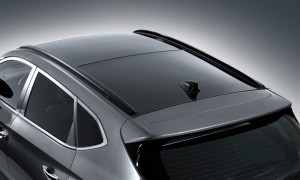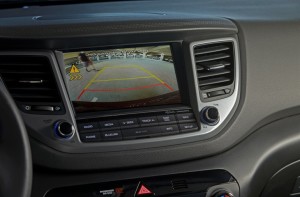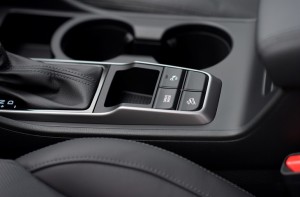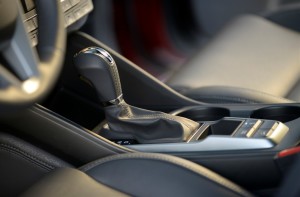Crossovers have won sizeable chunks of space on the roads, in parking lots, in dealer showrooms and particularly in the hearts of car buyers. Just about every automaker in the world offers a crossover, and it’s into this competitive niche that Hyundai has introduced the 2016 Tucson.

image courtesy Hyundai
First impressions
Hyundai’s designers added a few nips and tucks to up the sportiness factor of this third-generation design. A wide, deep, vertical front grill meets narrow headlights at the inside corners. Scalloped doors lead the eyes from front to back, where taillights protrude slightly from the generous back end.
Standing by the back end of my Ruby Wine tester, the Tucson beeped and flashed its lights for a couple of seconds. Then the “smart liftgate” opened wide to give access to a generous cargo area. I didn’t have to touch a thing, which was convenient since I was weighed down by my hockey bag and sticks.
Interior/Cabin
Comfortable cream-coloured leather seats greet each passenger. Front passengers get heat in their seats, while the driver gets a heated steering wheel. Less than a minute’s fiddling with power-seating adjustments left me quite comfortable. Instruments and controls are logically laid out and easy to reach.
While using certain controls (like wiper speed or driving mode) the Tucson automatically flashes the change on a screen in the middle of the instrument cluster.
The back seat is tall enough for me. Legroom proved sufficient even if the driver in front is as tall (6’5″) as I am.
The panoramic sunroof gives everybody in the vehicle access to some extra Vitamin D.

image courtesy Hyundai
Hockey bag test
The Tucson easily gulps the bag with room for one or two more before you need to think about folding one of the 60-40 split rear seats.

In-car technology
An 8” touchscreen (5” on base and Premium trims) provides access to a variety of features.

image courtesy Hyundai
Sound quality was great, especially when I was on the road to my 6:30 AM hockey games trying to get pumped up.
The navigation system and other settings are well laid out, though some of the on-screen controls are a little too small for my liking. Given the generous size of the screen, UX designers could have made certain touch controls larger.
Hyundai includes the ubiquitous steering-wheel-mounted audio system controls, but the Tucson comes with a little something extra. Press the volume control lever, instead of moving it up or down, and the system mutes. Press it again and the system unmakes. It’s a small detail, but it made the vehicle that little bit more refined.
Driving
The combination of Tucson’s 2-litre, 164-horsepower 4-cylinder engine and 6-speed automatic transmission proved peppy enough in ordinary driving. Hyundai also offers Tucson buyers a second engine option with a 175-horsepower 1.6L turbocharged GDI 4-cylinder engine mated to a segment-first 7-speed dual clutch transmission.
Drivers can change the Tucson’s character using Drive Mode Select. The vehicle starts up in “normal” mode. Go to Eco mode for better fuel efficiency at the cost of performance. Use Sport mode for the opposite tradeoffs.
One thing I miss about manual transmissions is the ability to gear down when on a hill to use the engine to control my speed. It’s handy when going down ramps like the one leading into my condo parking garage, or steep declines like some of the hills in my neighbourhood. The Tucson features a downhill brake control switch that replicates the braking power of gearing a car down manually.
For some reason, Tucson designers put this button mid-thigh to the driver. To use it, I had to glance down, i.e. take my eyes off the road. Otherwise, you might not press the right one of four buttons located there. Controls like this should reside ahead of the shift lever, at minimum, or higher up on the centre console.

image courtesy Hyundai

The downhill brake control button resides behind the gear shift lever. image courtesy Hyundai
Active safety features include blind spot detection, which I learned of thanks to one of the more insistently audible warnings I’ve ever heard in a vehicle. Other available options include:
- Rear Cross Traffic Alert (which uses some of the same sensors)
- Automatic Emergency Braking with pedestrian detection
- Lane Departure Warning System
- Lane Change Assist
- Rear Parking Sensors
- Active Cornering Control, which automatically transfers torque to the wheels with the most traction.
There’s a full gamut of passive safety features too, from airbags to crumple zones to Hyundai’s other day job – advanced metallurgy. At February’s Canadian International Auto Show, Hyundai representatives made a point of showing how much stronger their metal is than that of other manufacturers. The 2016 Tucson gets more than 50 percent Advanced High Strength steel compared with 18 percent for the former model. Hyundai also upped its assembly game to make the Tucson safer.
Pricing
Hyundai gives Tucson buyers five trim levels to choose from. MSRP starts at $24,399.